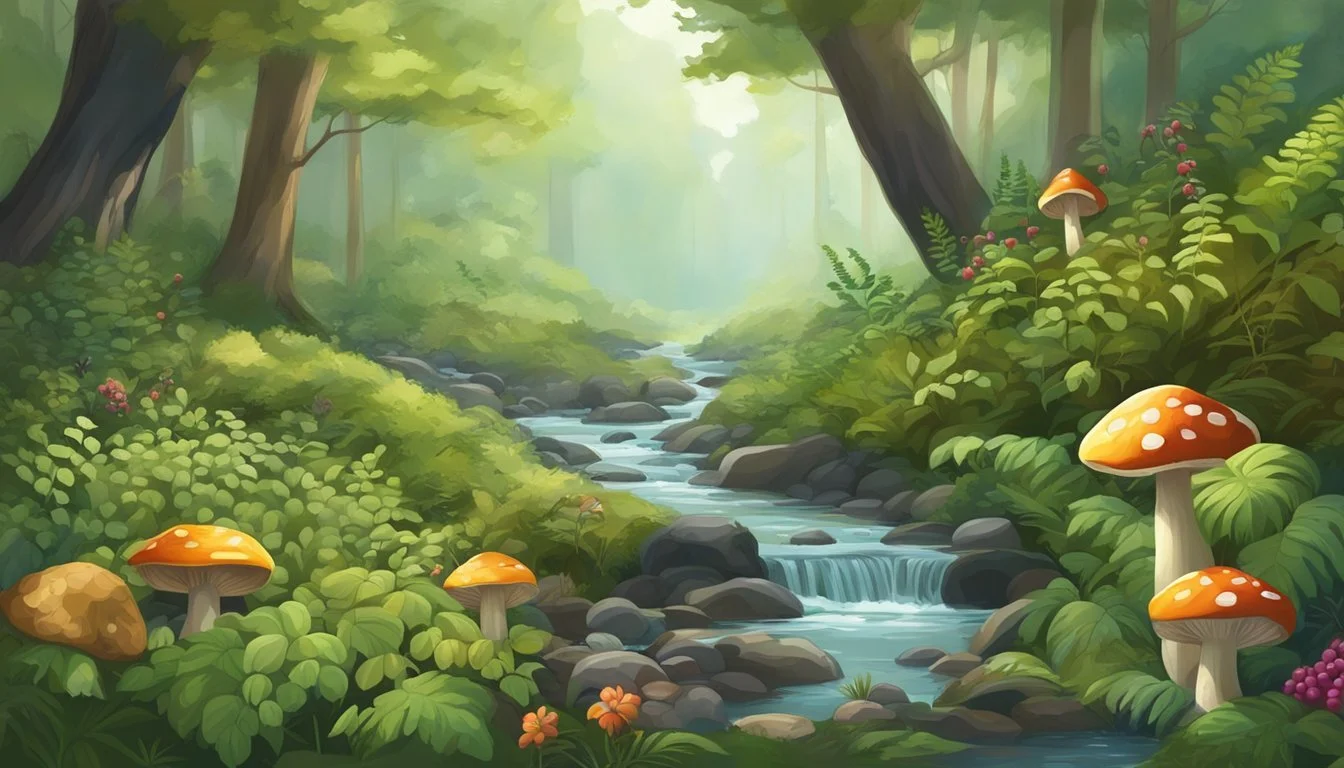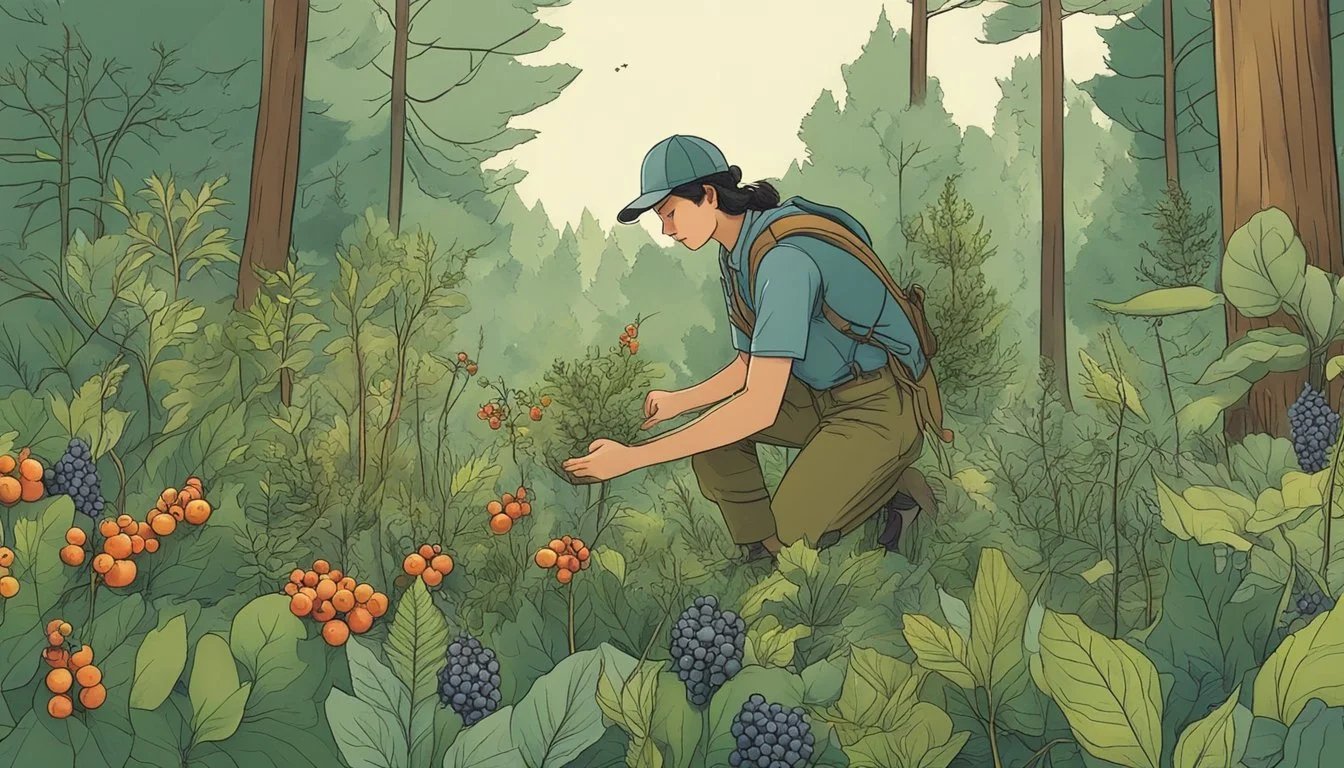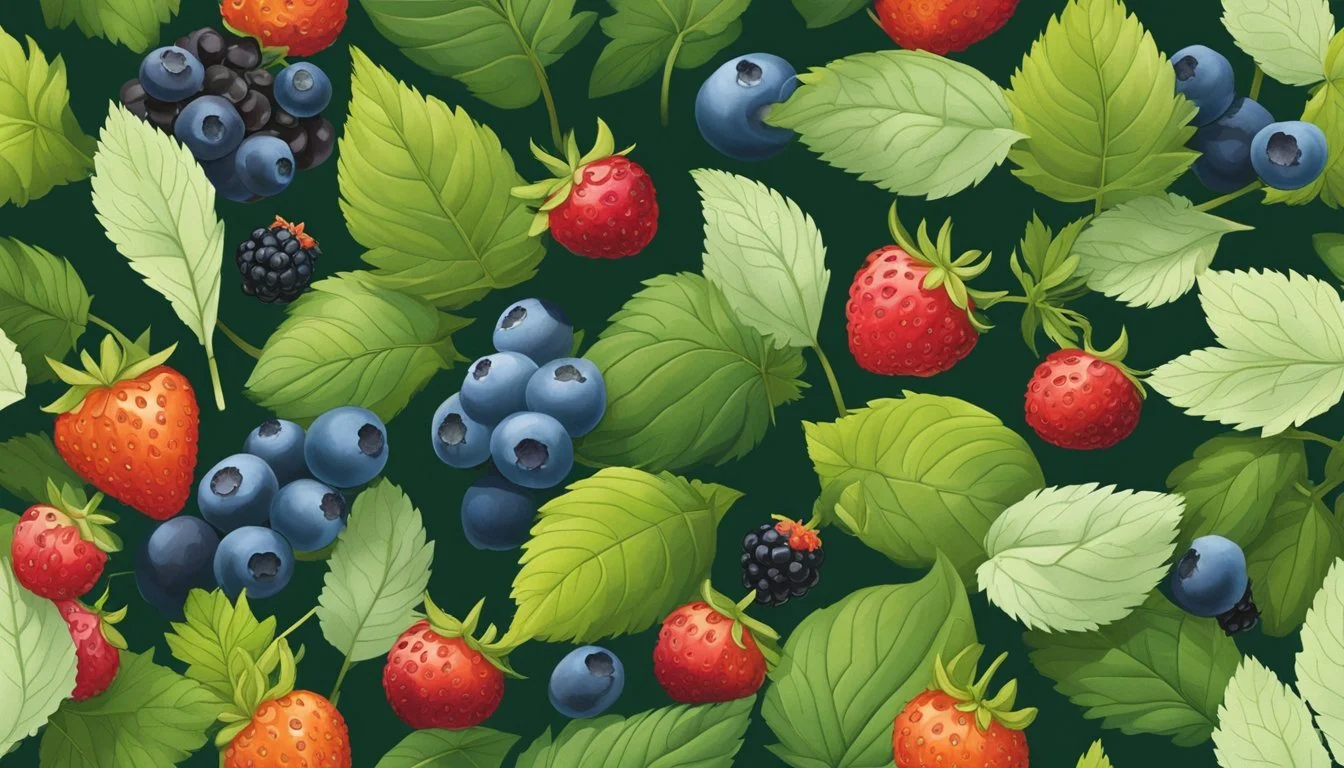Mid-Atlantic Native Edible Plants
A Guide to Local Foraging
Native edible plants from the Mid-Atlantic region offer an incredible array of flavors and nutritional benefits, making them an excellent addition to both gardens and diets. The pawpaw (Asimina triloba), with its large, tropical-like fruit, stands out as the largest edible fruit native to the United States. This hidden gem of Mid-Atlantic forests has been cherished for its custard-like texture and rich flavor.
Another notable plant is the American persimmon (Diospyros virginiana), known for its sweet, honey-like taste once fully ripe. It thrives in the Mid-Atlantic climate and contributes significantly to local ecosystems by providing food for wildlife and humans alike. These plants are not only delicious but also play a crucial role in maintaining the biodiversity and health of the region's environment.
Spicebush (Lindera benzoin) is another excellent choice, offering both culinary and medicinal benefits. Its berries can be used as a spice, and its leaves make a flavorful tea, adding variety to your garden’s yield. By incorporating these native edible plants into their gardens, individuals can enjoy unique flavors while supporting local wildlife and promoting ecological balance.
Understanding the Mid-Atlantic Region
The Mid-Atlantic region of the United States includes Maryland, Delaware, Pennsylvania, Virginia, and the District of Columbia. This area is known for its diverse geography and climate that influences the native plant species thriving here.
Geography and Topography
The Mid-Atlantic region comprises several distinct topographical areas. The Coastal Plain stretches from New Jersey down to Virginia, characterized by flat, low-lying terrain that is often marshy. These plains are crucial for agriculture and are home to specific native edible plants, including strawberries and various herbs.
Moving west, the region transitions to the Piedmont, a plateau that features rolling hills and rich, fertile soil. This area supports a different variety of native plants due to its elevation and soil composition.
Further west, the Allegheny Mountains form part of the larger Appalachian range, bringing mountainous terrain with higher altitudes and cooler temperatures. This varied topography impacts the types of edible native plants found throughout the region, creating unique microclimates suitable for specific species.
Climate and Seasons
The Mid-Atlantic's climate is largely temperate, influenced by both coastal and inland weather patterns. Summers tend to be hot and humid, with temperatures often reaching the high 80s and 90s°F. This heat supports the growth of many summer plants but can pose challenges for moisture-sensitive species.
Winters can be cold, especially in the mountainous Allegheny areas. Snowfall varies significantly, with heavier accumulations in the west compared to the coastal regions, impacting plant resilience and dormancy periods.
Spring and fall are transitional seasons, offering moderate temperatures and variable rainfall. Spring heralds new growth and blossoms, while fall provides a cooling period conducive to certain late-season crops. Understanding these seasonal variations is crucial for planning and nurturing native edible plants effectively.
Benefits of Growing Native Plants
Growing native plants in your garden or yard provides numerous benefits. They offer essential ecosystem services and attract a variety of pollinators and birds, enhancing biodiversity and the ecological health of your local environment.
Ecosystem Services
Native plants are well-adapted to the local climate and soil conditions, requiring less water and fewer fertilizers than non-native species. This reduces maintenance and conserves resources.
They also help in preventing soil erosion due to their deep root systems, which stabilize the ground and maintain soil health. Additionally, native plants support a diverse range of wildlife, providing food and habitat for various species.
Another advantage is that native plants can improve air quality by absorbing pollutants and producing oxygen. Furthermore, they contribute to carbon sequestration, mitigating the effects of climate change.
Attracting Pollinators and Birds
Native plants are crucial for attracting pollinators like bees, butterflies, and other insects. These plants often bloom at the right time to provide nectar and pollen, essential for the life cycles of these beneficial creatures.
Certain native species, such as the serviceberry (Amelanchier spp.), also attract birds by providing berries and seeds as food sources. Birds, in turn, help in seed dispersal, promoting plant propagation and biodiversity.
Including a variety of native plants in gardens ensures continuous bloom throughout the growing season, offering consistent food sources for pollinators and birds and contributing to a vibrant and healthy ecosystem in your yard.
Selecting Native Edible Plants
Choosing native edible plants for your Mid-Atlantic garden involves understanding the ecological benefits and selecting species that thrive in the region’s climate. This ensures a sustainable garden that supports local wildlife and provides a variety of flavors.
Trees and Shrubs
Native trees and shrubs offer multiple benefits, including providing food for both humans and wildlife. Pawpaw (Asimina triloba), a small tree native to the Mid-Atlantic, bears large, sweet fruits with a custard-like texture. Pawpaw cultivars such as PA Gold and Allegheny vary in size and color.
Another option is the Serviceberry (Amelanchier spp.), also known as shadbush. Its berries are sweet and can be used in various culinary dishes. The spring flowers attract early pollinators, and its leaves provide food for caterpillars.
Blackberry and raspberry shrubs are also valuable. These hardy plants produce abundant, nutritious berries and grow well in the diverse soils of the Mid-Atlantic. They require minimal care and can form natural hedgerows, enhancing garden biodiversity.
Herbaceous Plants
Herbaceous plants include perennials and other non-woody plants that can be integral to a native edible landscape. Wild strawberries (Fragaria virginiana) spread quickly and produce small but flavorful berries. They also serve as a ground cover, preventing soil erosion.
Bee balm (Monarda didyma), in addition to being edible, draws pollinators like bees and butterflies. Its leaves can be used to make teas, adding both function and beauty to the garden.
Ramps (Allium tricoccum), a type of wild leek, are sought after for their strong, garlicky taste. Ramps grow in shaded areas, often under trees, making them suitable for forest gardens.
Lastly, consider Violets (Viola spp.), whose flowers and leaves are edible. These perennials offer a mild flavor and can be used in salads or as garnish, adding visual appeal and variety to edible gardens.
Designing Your Native Plant Garden
A well-crafted native plant garden can be both beautiful and functional, providing ecological benefits and requiring thoughtful maintenance. Here are some guidelines to help you achieve that balance.
Creating Aesthetic Appeal
When designing your native plant garden, consider color, structure, and seasonal interest. Opt for a mix of plants that bloom at different times to ensure a display of colors throughout the year. For example, Serviceberry (Amelanchier spp.) offers spring flowers and vibrant fall foliage.
Incorporate plants with varying heights and textures to create visual layers. Pawpaw trees (Asimina triloba) can serve as an attractive canopy, while perennial herbs and groundcovers add depth. Group plants in clusters rather than line-by-line to mimic natural growth patterns and enhance aesthetic cohesion.
Maintenance Considerations
Maintaining a native plant garden requires planning to minimize labor while supporting plant health. Choose plants known for resilience and adaptability to local conditions. Sweetbay Magnolia (Magnolia virginiana), for example, thrives with minimal care.
Consider soil type, sunlight, and moisture levels to select appropriate plant species. Mulching helps retain soil moisture and suppresses weeds, reducing the need for constant watering and weeding. Regular pruning and deadheading will keep plants vigorous and looking their best, ensuring a tidy and vibrant garden.
Propagation and Cultivation
To successfully propagate and cultivate native edible plants in the Mid-Atlantic, it's essential to understand their preferred growing conditions and the best planting techniques. Adequate knowledge of both will help ensure healthy growth and optimal yields.
Growing Conditions
Native edible plants in the Mid-Atlantic thrive in diverse conditions, often mimicking their natural habitats. For instance, Pawpaw (Asimina triloba) prefers rich, well-draining soil with partial to full shade, while Serviceberry (Amelanchier spp.) can tolerate various soil types but flourishes best in moist, well-drained soils with full sun to partial shade.
Soil pH should typically be neutral to slightly acidic, generally ranging from 6.0 to 7.5. Regular mulching helps retain soil moisture and suppress weeds. Maintaining a consistent watering schedule during dry periods is vital, particularly in the early stages of plant development.
Planting Techniques
Propagation methods vary among species. Pawpaw is best grown from seed, which requires stratification (a period of cold treatment) to break dormancy. Seeds should be sown in pots and kept in a refrigerator for 90-120 days before planting in spring. Roots should be handled minimally to avoid damage.
Serviceberry can be propagated via seeds, cuttings, or suckers. Seeds should be sown in the fall and may need cold stratification. Cuttings should be taken from young, healthy plants and rooted in a sandy medium under mist.
Spacing is crucial to prevent overcrowded growth. Pawpaw trees require at least 15-20 feet between plants, while serviceberries are planted 6-10 feet apart. Regular pruning ensures healthy growth and promotes fruit production.
Featured Native Edible Plants
This section highlights three key native edible plants: Serviceberry, American Persimmon, and Pawpaw, all of which are well-adapted to the Mid-Atlantic region.
Serviceberry
Serviceberry, also known as shadbush (Amelanchier spp.), is a small tree or shrub that produces sweet, blueberry-like fruits. The berries ripen in early summer and are loved by both humans and wildlife. The fruits can be eaten fresh, made into jams, or baked into pies.
Serviceberry plants are hardy and can thrive in various soil types, though they prefer well-drained soils. They also provide beautiful white flowers in spring, which attract early pollinators. Besides their edible berries, they serve as a host plant for butterfly larvae, including the Red-spotted Purple butterfly (Limenitis arthemis).
American Persimmon
American Persimmon (Diospyros virginiana) is native to the southern and eastern United States. The fruit is sweet and rich when fully ripe, with a flavor that improves after the first frost. These persimmons can be eaten fresh or used in baking and cooking.
The tree is adaptable, thriving in a variety of soil conditions, though it prefers well-drained, slightly acidic soils. American Persimmon trees are also known for their hard, attractive wood, which was historically used for making golf club heads and other items.
Pawpaw
Pawpaw (Asimina triloba) is often called the tropical fruit of the temperate zone. This plant produces large, mango-like fruits with a creamy texture and a flavor reminiscent of banana and mango. Pawpaw fruits are rich in nutrients and can be eaten fresh or used in desserts and smoothies.
Pawpaw trees prefer rich, well-drained soils and are often found in river valleys and floodplains. They require cross-pollination from another genetically different tree to produce fruit. Besides their fruits, the trees have an attractive form and large, lush leaves, making them a good addition to gardens.
These featured native edible plants are suitable for the Mid-Atlantic region and provide both ecological benefits and delicious fruits.
Common Challenges in Growing Edibles
Growing edible plants in the Mid-Atlantic region poses several challenges. Key issues include managing pests and diseases and controlling invasive plants, which can disrupt the natural ecosystem and reduce crop yield.
Dealing with Pests and Diseases
Pests, such as aphids, caterpillars, and beetles, are a common problem for gardeners. These insects can cause significant damage to leaves, stems, and fruits. To mitigate these issues, gardeners can use organic insecticides, introduce natural predators like ladybugs, or implement crop rotation to prevent pest build-up.
Diseases, such as powdery mildew and bacterial wilt, can also affect plant health. Ensuring proper air circulation, using disease-resistant plant varieties, and applying fungicides when necessary can help manage these problems. Regularly inspecting plants for symptoms and removing any infected plants promptly can prevent the spread of diseases.
Controlling Invasive Plants
Invasive plants like Japanese Knotweed and Mile-a-Minute weed can overtake garden spaces, crowding out native edibles. These plants can spread rapidly and compete for resources such as nutrients, light, and water.
Effective control strategies involve regular monitoring and early removal of invasive species. Mulching and cover cropping can also suppress the growth of invasives. In severe cases, herbicides may be required, though they should be used with caution to avoid harming desirable plants. Maintaining a diverse and well-managed garden environment can help minimize the risk and impact of invasive plants.
Conservation and Sustainable Foraging
Conservation of native varieties and ethical harvesting practices are critical for maintaining the ecosystem and ensuring that native plants continue to thrive. These principles guide foragers in benefiting from native plants without causing harm to the environment.
Protecting Native Varieties
Protecting native varieties involves several practices aimed at preserving the existing flora. This includes:
Avoiding over-harvesting: Harvesting too much can deplete plant populations, reducing their ability to reproduce.
Supporting local conservation efforts: Engaging in and contributing to local initiatives ensures that habitats and native species are safeguarded.
Cultivating native plants: By planting native varieties in personal gardens, individuals can help bolster populations and reduce pressure on wild resources.
Educating the community: Raising awareness about the importance of native plants can foster a culture of respect and care.
Protecting native wetland plants is particularly crucial, as these species often play a role in water purification and soil stabilization.
Ethical Harvesting Practices
Ethical harvesting practices ensure that foragers collect plants sustainably and respectfully. Key guidelines include:
Harvesting in moderation: Take only what is needed, leaving enough for wildlife and future growth.
Seasonal awareness: Knowing the right seasons to harvest certain plants helps avoid disrupting their life cycles.
Avoiding endangered species: Refraining from harvesting rare or endangered plants supports biodiversity.
Respecting the habitat: Ensuring minimal impact on surrounding areas helps maintain ecological balance.
Ethical harvesting can significantly impact the sustainability of foraging activities. Implementing these practices aids in preserving the environment while enjoying its natural offerings.
Together, these strategies support both the conservation of native plant varieties and the sustainable use of natural resources.
Additional Resources
For those interested in Mid-Atlantic native edible plants, there are numerous resources available that provide detailed insights, fact sheets, and guidance from reputable organizations and programs.
Fact Sheets and Guides
Numerous organizations offer comprehensive fact sheets and guides that detail the identification, growth requirements, and potential uses of native edible plants. The University of Maryland Extension provides important literature on plants beneficial to native bees and other pollinators. These guides often include specifics on soil requirements, bloom times, and sunlight needs.
The Lady Bird Johnson Wildflower Center is another excellent resource. They have an array of lists detailing plants native to different states and their corresponding ecological benefits. Users can find valuable information about plant characteristics that will contribute effectively to home gardens.
Regional Organizations and Programs
Several regional organizations and programs are dedicated to the promotion and preservation of native plants. Plant NOVA Natives offers guidance and resources specifically tailored to the Northern Virginia area. Their initiatives focus on native plant preservation and public education.
The Chesapeake Bay Watershed program supports efforts to protect and restore native plant species within the watershed. They provide resources on how native plants contribute to the overall health of the ecosystem, including improving water quality and providing habitat for local wildlife.
Other notable mentions include the United States Botanic Garden, which has a curated list of favorite native plants designed to attract pollinators and other beneficial animals to home gardens. These regional initiatives play a pivotal role in maintaining ecological balance and promoting sustainable gardening practices.











